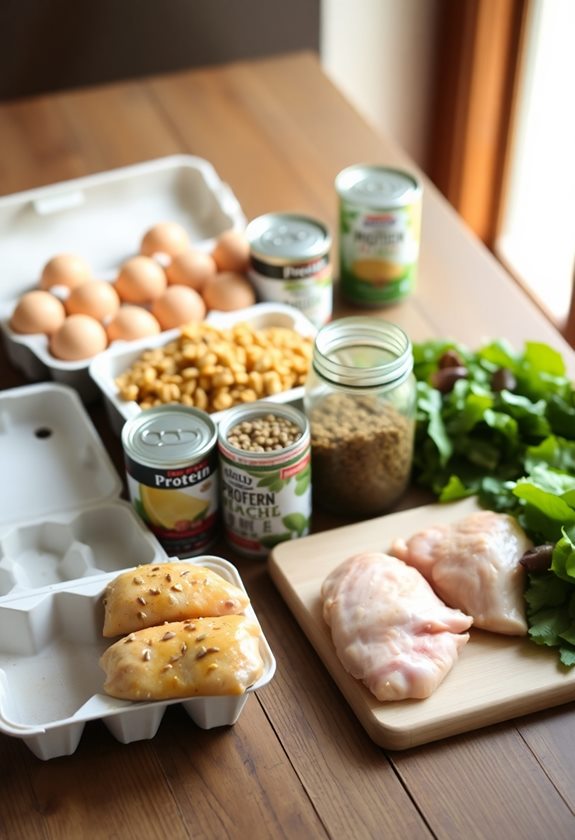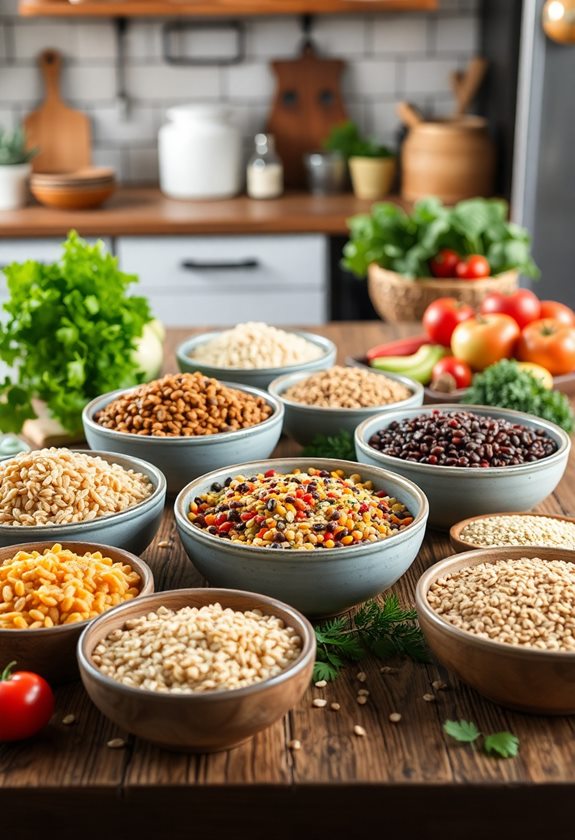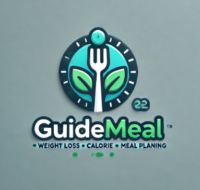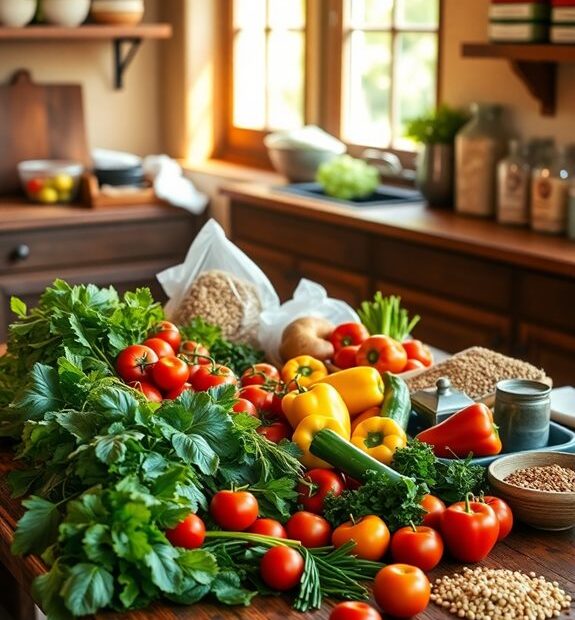If you want to save money while eating healthy, an essential grocery list is key! Start with fruits and vegetables; they add flavor and nutrients to your meals. Don't forget grains like rice and pasta, which are filling and versatile. For protein, consider budget-friendly options like canned beans and eggs. These foods are not just cheap, but they also help you create delicious meals. By making a shopping list and looking for seasonal produce, you can avoid impulse buys. Want to know more tips for making meal planning easier and cheaper? There's plenty more to explore! 🌟
Key Takeaways
- Include fresh, seasonal fruits and vegetables to enhance nutrition and reduce costs.
- Stock up on budget-friendly proteins like canned beans, eggs, and peanut butter for versatile meal options.
- Choose grains such as rice, pasta, and oats as affordable, filling bases for meals.
- Utilize canned goods for long-lasting, cost-effective ingredients that add variety to meals.
- Create a shopping list and monitor sales to avoid impulse buys and maximize savings.
Benefits of Meal Planning

Meal planning offers numerous benefits that can simplify your life in the kitchen. Have you ever felt overwhelmed by deciding what to cook each day? With meal planning, you can save that stress. You'll know exactly what you're making and when, making your week smoother. By aligning your meal prep with your workout routine, you can enhance your nutrition and boost your metabolism, leading to more effective results in your fitness journey synergy of meal planning and physical activity.
Imagine having all your meals ready to go! Meal planning helps you use ingredients efficiently, reducing waste. Instead of tossing out spoiled food, you'll enjoy fresh meals all week. Plus, it can save you money! When you plan your meals, you can buy only what you need, avoiding those impulse purchases that can add up quickly.
Another perk? You'll eat healthier. By planning your meals, you can include more fruits and veggies, making it easier to stick to your nutrition goals. Have you ever noticed how easy it is to grab fast food when you haven't planned?
Lastly, meal planning can actually save you time. You'll spend less time in the kitchen each day. Instead, you can enjoy family time or hobbies. So why not give meal planning a try? You might find it's just what you need to make your life easier!
Key Grocery List Items
Planning your meals is only part of the equation; knowing what to buy is just as important. Have you ever walked into a grocery store and felt overwhelmed? It's easy to get lost in aisles filled with choices! To make your shopping experience smoother, let's focus on some key grocery list items.
Start with fruits and vegetables. Fresh produce not only adds flavor but also nutrients to your meals. Think about what's in season—it's often cheaper and tastier! For instance, incorporating nutrient-rich avocados can enhance your dishes with healthy fats and essential vitamins. Next, grains like rice, pasta, and quinoa are staples that can form the base of many dishes. They're filling and versatile.
Don't forget about dairy or dairy alternatives. Items like milk, yogurt, and cheese can enhance your meals. Finally, consider canned goods like beans and tomatoes. They're inexpensive, last a long time, and can save you in a pinch.
Budget-Friendly Protein Options

When it comes to filling your plate without breaking the bank, budget-friendly protein options are essential. You don't need to spend a fortune to eat well! Here are some tasty and affordable protein choices that can keep you satisfied.
| Protein Source | Approx. Cost per Serving |
|---|---|
| Canned Beans | $0.50 |
| Eggs | $0.20 |
| Peanut Butter | $0.30 |
Have you ever thought about how much money you can save with these options? Canned beans are not only cheap but also packed with protein and fiber. Eggs are versatile too—scramble them, boil them, or make an omelet! And don't forget about peanut butter; it's a delicious spread that adds protein to your snacks.
Mix these ingredients into your meals, and you'll feel full without feeling guilty about your wallet. Why not try a bean chili or an egg salad sandwich this week? You'll see that eating on a budget can be both healthy and fun. Embrace these protein options and watch your savings grow! 💰🥚
Affordable Fruits and Vegetables
Eating a variety of affordable fruits and vegetables can make a significant difference in your meal planning and overall health. Have you ever noticed how colorful fruits and veggies can brighten up your plate? Not only do they look great, but they're also packed with vitamins and minerals that your body needs. Incorporating these nutrient-dense foods into your diet supports healthy eating habits and aligns with your structured meal planning efforts. When you're shopping, think seasonal. Fruits like apples, bananas, and oranges are usually less expensive and available year-round. Vegetables like carrots, potatoes, and cabbage often cost less too. Plus, they last longer, so you won't waste money on spoiled food. 🌿🥥
You might wonder how to incorporate more of these into your meals. Try adding spinach to your morning smoothie or roasting seasonal veggies as a side dish. It's easy and delicious!
Don't forget about frozen fruits and vegetables—they're just as nutritious and can save you money. They're perfect for quick meals and snacks.
Cost-Effective Grains and Staples

Incorporating cost-effective grains and staples into your grocery list can greatly boost your meal planning budget. Why not start with rice? It's cheap, filling, and versatile. You can pair it with veggies, beans, or meats, making it perfect for any meal.
Next, consider pasta. You can whip up a meal in no time! It's great for quick dinners, and you can toss in whatever you have on hand. Plus, it stores well for those busy nights.
Don't forget about oats! They're not just for breakfast. You can use them in snacks or even baking. How about a batch of oatmeal cookies? Yum!
Quinoa is another fantastic choice. It's packed with protein and can be a base for salads or bowls.
Lastly, grab some canned beans. They're budget-friendly and add protein and fiber to your meals. You can throw them in soups, stews, or salads.
Tips for Smart Shopping
Smart shopping can greatly enhance your meal planning experience, especially after stocking up on cost-effective grains and staples. You don't have to spend a fortune to eat well! With a few simple tips, you can save money and make meal prep easier.
Here are some smart shopping strategies to keep in mind:
- Make a List: Write down what you need before heading to the store. This helps you avoid impulse buys.
- Shop Sales: Check your store's weekly ads for discounts. Buying what's on sale can save you a lot!
- Buy in Bulk: Items like rice, beans, and pasta are often cheaper when purchased in larger quantities.
- Use Coupons: Look for coupons online or in newspapers. Every little bit helps!
- Seasonal Produce: Buy fruits and veggies that are in season. They're usually fresher and cheaper!
Have you ever walked out of a store with more than you planned? With these tips, you can stick to your budget and still enjoy delicious meals. Remember, smart shopping isn't just about saving money; it's about making your time in the kitchen enjoyable and stress-free! Happy shopping! 🛒✨
Frequently Asked Questions
How Can I Create a Meal Plan for Beginners?
To create a meal plan as a beginner, start by choosing simple recipes you enjoy. Set a schedule, list ingredients, and prep in advance. Don't forget to keep meals balanced and adjust based on your preferences.
What Tools Can Help With Meal Planning and Grocery Lists?
Think of meal planning like a treasure map. You can use apps, planners, or spreadsheets to organize your meals and grocery lists. These tools help you stay focused, save time, and make shopping a breeze!
Are There Apps for Tracking Grocery Expenses?
Yes, there are several apps for tracking grocery expenses. You can use apps like Mint, YNAB, or Grocery Tracker, which help you monitor spending and manage your budget effectively while shopping.
How Do I Manage Leftovers Effectively in Meal Planning?
To manage leftovers effectively, you should store them in clear containers, label them with dates, and plan meals around them. This way, you'll minimize waste and make your meal prep more efficient.
Can I Meal Plan for Dietary Restrictions Easily?
Absolutely, you can meal plan for dietary restrictions easily. Picture a colorful plate filled with your favorites, all tailored to your needs. Just focus on fresh ingredients, and you'll create delicious, satisfying meals in no time!

